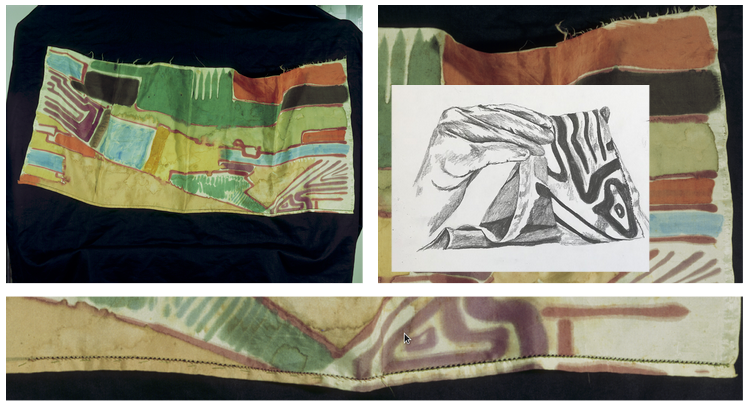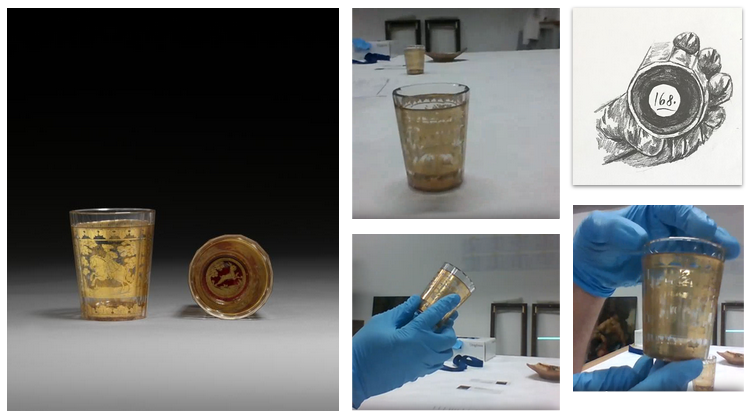The whittling down has begun. As I found myself with four beautiful intriguing objects in the initial research I finally got myself down to two, with further insights leading me to think about these objects in terms of science and design and the possibilities surrounding them.

One of the first things I looked at was the piece’s construction – is it even a scarf? Who labelled it as this? The selvedge, an edge produced on woven fabric during manufacture that prevents it from unravelling, is seen here on both sides of the fabric. There is one raw side and one finished side that has been machine-stitched but also has some hand-stitched or basting stitches running along its edge. This suggests it is the width of a piece of fabric, torn away and experimented on, in other words, a fragment. The design is playful, the colours bleed into one another and there are some water damage marks. But the damage almost integrates with the bleeding design and adds to its wear and tear effect. This suggests to me the idea of the Japanese aesthetic known as Wabi-Sabi – where the aesthetic is described as one of beauty if an object is imperfect, impermanent and incomplete. It is very delicate and moves beautifully when held up. As it is silk, there is a slight shine to it that ripples in the light and creates a translucent effect. Viewed horizontally it may be reminiscent of an aerial view of fields and swimming pools. But viewed vertically, it can be interpreted as more abstract, possibly more free of the viewer’s suggestion.
The piece tells a story of material culture of the time with it being made at the outbreak of the First World War as well as being just after the Arts & Craft movement, with how it encapsulates a changing moment of how artists related to technology. The art critic, writer and artist Roger Fry founded the Omega Workshops in 1913 partly as a reaction against the machine-made. I was also reminded of the ‘Unbound Exhibition’ at Two Temple Place, and I have been thinking about how women collectors of textiles in this period were looking at the social and cultural importance of textiles through imaginative collecting. This piece was given to the Courtauld gallery by Winifred Gill, a craftswoman and social reformer. I have been reflecting how textiles often have to fight for their place amongst the more established visual arts. Textiles are part of our everyday life. They are familiar but powerful objects.
Goldzwischenglas Cups, c.1720-40, Bohemia O.1966.GP.168

These are a pair of faceted goldzwischenglas beakers, basically gold sandwiched glass, which is an exquisite technique of a double glass, in which the first glass is decorated in gold leaf with the second glass precisely fitting in to sandwich the gold leaf in place, making one cup. The technique was developed during the Roman Empire and was revived in Bohemia and Austria in the 18th century, which is where these beakers are from.
The design all around shows a stag hunting scene. A running hare is seen on the base of each beaker. The bases are constructed separately from the glass cylinders and are of red lacquer glass. The two cups are very slightly different in their narrative illustration. In terms of personal taste and design I wasn’t drawn to them for their luxurious gold look, as I prefer items more rough around the edges but I was drawn to them for their delicate illustration and size. Upon closer inspection and discussion with the gallery’s technician Matthew Thompson, whilst he was in the storage unit and I was at home on my laptop, they really began to be quite the conversation piece, literally and metaphorically. They are functionally an everyday object, a glass, a cup or beaker, hand-held and used for liquids. Such beakers were conversation pieces for wealthy collectors, therefore I am imagining them being used whilst discussing the day’s hunt. They are faceted all the way around, making a confusing, blurred, double-image effect, which can be quite distracting from the scene when initially first looking at them. You lose the visual quality of the glass, and are experiencing the image in front and the image behind at the same time depending on the light behind them.
How would they change with different coloured liquids in them perhaps? They are very rich for a designer to explore. We can also continue the narrative by hunting for our meaning within the piece. Are we chasing more than the stag and the hare? This double-image effect almost becomes 3D upon rotation, like a dream sequence or an early period moving image. They become something more than this exquisite technique, an immersive environment of telling a story through different backgrounds, different liquids telling the same story in a completely different way. What if we flattened the image down to become a story board, how would the story enfold, how would the story begin? With its intriguing link to chemistry and glass-making this is an object with many creative possibilities.
The varying ways in which I have engaged through the project over lockdown have brought me to these two wondrous objects. I am very excited to delve further into the specific research for the final chosen one!

